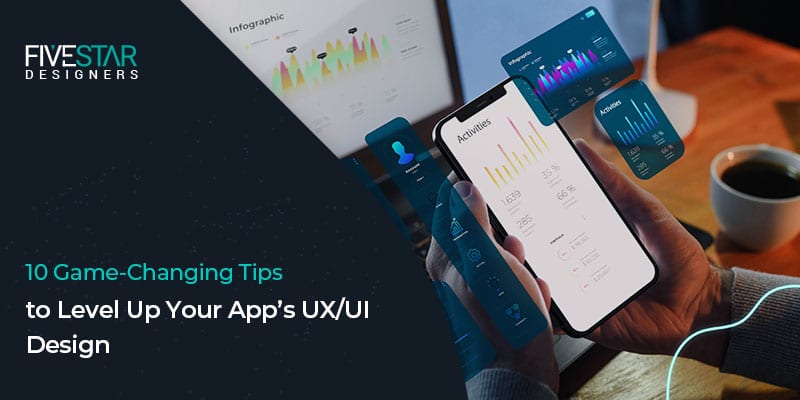If you follow the app development community, you might’ve noticed a growing trend among developers neglecting the need to spend more time and resources on developing UX/UI and focusing more on functionality.
A recent poll was conducted that revealed 59% of app developers prioritize functionality over UX/UI whereas 41% believe the key to a successful app lies in the experience it provides rather than its function. However, a stronger correlation between the app’s design and its success rate has been observed.
So how can an app development company maximize its sales by giving its users a better
experience? Let’s see what we can do to juice up an app’s UX/UI.
1. Know Thy User
To give the app an aesthetically pleasing look, an app developer should know precisely what they need to design, and for that, they should conduct competitive research, surveys, and anything at their disposal to catch the exact vibe for said app.
This is a crucial step for app development agencies to talk to their clients about how they envision their app to be and look like. Google Analytics, Mixpanel, Hotjar, and Maze have been proven to be really helpful tools for gathering information about preferences and behavior.
2. Keep It Simple, Stupid (KISS)
Design dynamics shift over time and as of 2025, app developers aim for a more minimalistic style. A clean and simple UI is usually the answer to creating an intuitive and futuristic UI.
High-contrast colors and flashy bright designs might work for some apps (usually children’s apps) but bloating up the interface with options and bright colors often times backfire. Take a look at all the best apps that are a part of our daily lives. Instagram, Spotify, and even Google Maps offer clean and dichromatic UI with minimal options that don’t overwhelm you.
3. Easy Navigation
Part of the UX is how the user navigates through the app. Going ham on designing a unique and peculiar navigation system might seem like a good idea but can potentially confuse users. Sticking to familiar patterns—bottom navigation bars for primary actions, hamburger menus for secondary options, and clear back buttons is usually the way to go.
For Android app development, follow Material Design guidelines. They’re not just pretty; they’re practical. And if you’re feeling fancy, add subtle animations to guide users through transitions.
4. Consider Speed a Feature
Speed is just as important for UX/UI as it is for functionality. The entire experience is ruined and a negative impression is created if your app lags or takes too long to load. Performance optimization isn’t just a backend thing—it impacts UX directly.
An app development company can address performance optimization problems in a variety of ways to shorten loading times. Using offline features, reducing JavaScript, incorporating lazy loading, and compressing images can all help your app run faster.
5. E For Everyone
A good way to rack up points for building a better user experience is by making your app inclusive to everyone. Making your app accessible to every audience is mandatory to an extent. It’s a win-win in terms of good business and ethics
Make sure anyone can use your app, including people with disabilities. Colorblind mode, high contrast colors option, and scalable fonts ensure everyone gets to enjoy the experience. If you’re a mobile app development company, this should be part of your standard workflow.
6. Cohesive And Consistent
Being consistent isn’t just constricted to UI designs. Consistency should be a part of your conduct as an app developer to create apps that are harmonious all around. Keeping the vibe cohesive across the app is a challenge in it of itself.
Figma or Sketch are great tools for building design systems. And if you’re working with an app development agency, make sure they’re on the same page. Consistency builds trust and makes your app feel polished.
7. The Test-Iterate Loop
You can’t improve what you don’t measure. Conduct usability testing with real users to identify friction points. A/B testing is also a great way to compare different designs and see what works best.
If you’re an app developer, don’t rely solely on your instincts. What makes sense to you might confuse others. Tools like UsabilityHub or Maze can streamline the testing process.
8. Introduce Micro interactions
Micro interactions are a great way to breathe life into your app. These subtle touches give depth to the app and oftentimes even become iconic and a symbol of recognition for the app.
These tiny animations or feedback loops, whilst being delightful can sometimes be distracting if overdone, the best course of action is to integrate micro interactions just enough to be fun and interactive and not to the point where it might actually be annoying.
9. Stay Updated with Trends
The tech world moves fast. Dark mode, neumorphism, glassmorphism—trends come and go. While it’s good to stay informed, don’t sacrifice usability for the sake of being trendy.
If you’re a mobile app development company, balance innovation with practicality. Use trends as inspiration, not a blueprint.
10. Listen to Feedback
The customer is always right. You should be open to criticism and listen to your users to truly get to know how you can improve their experience further.
For an app development agency, post-launch support is a crucial service that helps to keep the client’s app relevant and fix any bugs that might appear. So many apps rise through the ranks solely by listening to their users.
Final Verdict
Let’s not forget the main purpose of enhancing our app’s UI, to provide a unique experience that not only satisfies your users but also one-up other apps in such a competitive market. These tips can be of great benefit for solo app developers or for whole mobile app app agencies
So, what are you waiting for? Go ahead, create apps that don’t just function but wow. And if you need help, well, that’s what app development agencies are for.
Now, go make something awesome.




